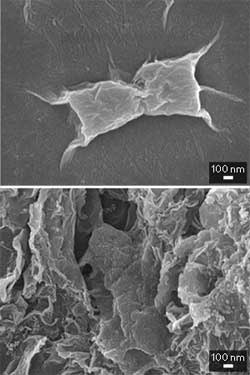Functional materials: Two ways to kill

Graphene oxide (top) kills bacterial cells through cell-wrapping, while reduced graphene oxide (bottom) kills bacterial cells through cell-trapping. © 2012 ACS<br>
The discovery of graphene has brought much excitement to the nanotechnology community. Much of this excitement is due to the possibility of deriving graphene-based materials with applications in electronics, energy storage, sensing and biomedical devices. Despite the potential, however, there is a real concern that graphene-based materials may have deleterious effects on human health and the natural environment.
One particularly interesting aspect of this subject is the toxic effects of graphene-based materials on the microscopic world of bacteria. For this very reason, Jun Wei at the A*STAR Singapore Institute of Manufacturing Technology and co-workers have now compared the antibacterial activity of graphite, graphite oxide, graphene oxide and reduced graphene oxide using the model bacterium Escherichia coli. They showed that the two graphene-based materials kill substantially more bacteria than two graphite-based materials — with graphene oxide being the top performer.
Interestingly, graphene oxide particles had the smallest size of all the four graphene materials as measured by dynamic light scattering. Wei and co-workers believe that particles of reduced graphene oxide were larger because they aggregated both laterally and in three dimensions.
In fact, the size of the particles could well be the key to why graphene oxide is so deadly to bacteria. When the researchers studied the affected cells using scanning electron microscopy, they saw that most of the E. coli cells were individually wrapped by layers of graphene oxide. In contrast, E. coli cells were usually embedded in the larger reduced-graphene-oxide aggregates (see image). A similar cell-trapping mechanism was operational in the graphite-based materials.
So why does cell-wrapping kill more cells than cell-trapping? The researchers believe that the direct contact of cell surface with graphene causes membrane stress and irreversible damage.
Wei and co-workers also investigated chemical mechanisms by which the materials could disrupt and kill bacteria. They found that the oxidation of glutathione, an important cellular antioxidant, occurred on exposure to graphite and reduced graphene oxide. “It might be that these structures act as conducting bridges extracting electrons from glutathione molecules and releasing them into the external environment,” says Wei.
Intriguingly, while the effect of the membrane-disrupting mechanisms dies away after four hours of incubation, the oxidation mechanism shows only minor changes.
“With the knowledge obtained in this study, we envision that physicochemical properties of graphene-based materials, such as the density of functional groups, size and conductivity can be better tailored to either reduce environmental risks or increase application potential,” says Wei.
The A*STAR-affiliated researchers contributing to this research are from the Singapore Institute of Manufacturing Technology
References:
Liu, S., Zeng, T. H., Hofmann, M., Burcombe, E., Wei, J. et al. Antibacterial activity of graphite, graphite oxide, graphene oxide and reduced graphene oxide: membrane and oxidative stress. ACS Nano 5, 6971–6980 (2011).
Media Contact
All latest news from the category: Materials Sciences
Materials management deals with the research, development, manufacturing and processing of raw and industrial materials. Key aspects here are biological and medical issues, which play an increasingly important role in this field.
innovations-report offers in-depth articles related to the development and application of materials and the structure and properties of new materials.
Newest articles

Bringing bio-inspired robots to life
Nebraska researcher Eric Markvicka gets NSF CAREER Award to pursue manufacture of novel materials for soft robotics and stretchable electronics. Engineers are increasingly eager to develop robots that mimic the…

Bella moths use poison to attract mates
Scientists are closer to finding out how. Pyrrolizidine alkaloids are as bitter and toxic as they are hard to pronounce. They’re produced by several different types of plants and are…

AI tool creates ‘synthetic’ images of cells
…for enhanced microscopy analysis. Observing individual cells through microscopes can reveal a range of important cell biological phenomena that frequently play a role in human diseases, but the process of…





















